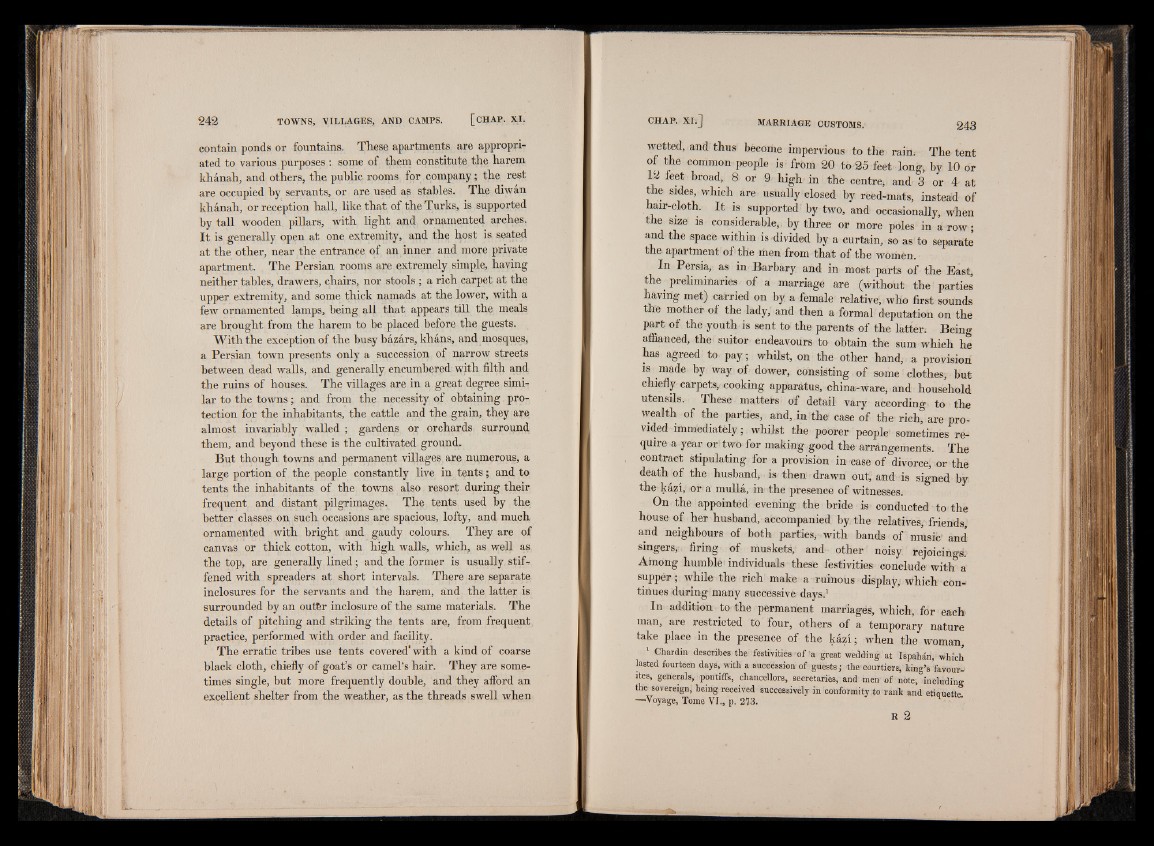
contain ponds or fountains. These apartments are appropriated
to various purposes : some of them constitute the harem
khanah, and others, the public rooms for company; the rest
are occupied by servants, or are used as stables. The diwan
khanah, or reception hall, like that of the Turks, is supported
by tall wooden pillars, with light and ornamented arches,
It is generally open at one extremity, and the host is seated
at the other, near the entrance of an inner and more private
apartment. The Persian rooms are extremely simple, having
neither tables, drawers, chairs, nor stools ; a rich carpet at the
upper extremity, and some thick narnads at the lower, with a
few ornamented lamps, being all that appears, till the meals
are brought from the harem to be placed before the guests.
With the exception of the busy bazars, khans, and mosques,
a Persian town presents only a succession of narrow streets
between dead walls, and generally encumbered with filth and
the ruins of houses. The villages are in a great degree similar
to the towns; and from the necessity of obtaining protection
for the inhabitants, the cattle and the grain, they are
almost invariably w'alled ; gardens or orchards surround,
them, and beyond these is the cultivated ground.
But though towns and permanent villages, are numerous, a
large portion of the people constantly live in tents; and to
tents the inhabitants of the towns also resort during their
frequent and distant pilgrimages. The tents used, by the
better classes on such occasions are spacious, lofty, and much
ornamented with bright and gaudy colours. They are of
canvas or thick cotton, with high walls, which, as well as,
the top, are generally lined; and the former is usually stiffened
with spreaders at short intervals. There are separate
inclosures for the servants and the harem, and the latter is
surrounded by an outer inclosure of the same materials. The
details of pitching and striking the tents are, from frequent
practice, performed with order and facility.
The erratic tribes use tents covered’ with a kind of coarse
black cloth, chiefly of goat’s or camel’s hair. They are sometimes
single, but more frequently double, and they afford an
excellent shelter from the weather, as the threads swell when
wetted, and thus' bècome impervious to the rain. The tent
of the common people is-from 20 to 25 feet long, by 10 of
H .^ broad> 8 or 9 high in the centre,, and- 3 or 4- at
the sides which are usually closed by reed-mats, instead of
hair-cloth. It is supported by two, and occasionally, when
the size is considerable,, by three or more poles in a row ;
and the spaee within is divided by a curtain, so as to separate
the apartment of the men from that of the women.
In Persia, as in Barbary and in most parts of the East,
the preliminaries of a marriage are (without the parties
having met) -carried on by a female relative1,,who first sounds
the mother of the lady, and then a formal deputation on the
part of the youth is sent to the parents of the latter. Being
affianced, the suitor endeavours to obtain the sum which he
has agreed to pay ; whilst, on the other hand, a provision
is made by way of dower, consisting of some clothes, but
chiefly carpets/cooking apparatus, china-ware, and household
utensils. These matters of detail vary according to the
wealth of the parties, and, in the case of the rich, are provided
immediately ;. whilst the poorer people' sometimes require
a year or'two for making good the arrangements. The
contract stipulating for a provision in case of divorce, or the
death of the husband, is then drawn out, and is signed by
the kazi, or a mulla, in the presence of witnesses.
On the appointed evening the bride is-conducted to the
house of her husband, accompanied by the relatives; friends,
and neighbours of both parties, with bands of music’ and
singers,, firing of muskets, and other noisy: rejoicings.
Among humble > individuals these festivities conclude with a
supper ; while the rich make a ruinous display; Which continues
during many successive days.1
In addition to the permanent marriages, which, for each
man, are restricted to four, others oi a temporary nature
take place in the presence of the kazi; when the woman,
Chardin describes the festivities-of1 a great wedding at Ispahdn, which
lasted fourteen days, with a succession' of guests ; the'courtiers, king’s favourites,
geilerals, pontiffs, chancellors, secretaries, and men of nòte; including
the sovereign, being received successively in conformity to'rank and etiauette.
—Voyage, Tome VI., p. 213. ■
R 2